The Complete 12-Step Guide on How to Perform a Local SEO Audit (Updated 2023)
When a business shows up on page 2 of Google, does it even exist? Sadly, the answer is no. Local search is competitive. When a customer searches for pizza near me, for example, Google gives three local options and 10 organic results. A typical searcher selects one of the top three options, orders pizza, and calls it a day. But if a local business doesn’t show up on that first page anywhere, how do you help the business? You start by conducting a local SEO audit of their website.
Skip the reading and grab your complete Local SEO checklist to dominate the local SERP for clients!
In this complete guide, we show you how to conduct a local SEO audit in 12 steps, a process that takes only 44 minutes. Along with the steps, this tutorial also includes a list of the tools you’ll need and expert tips from our in-house analysts.
If you want a handy checklist, you’ll love our complete Local SEO Checklist.
Ready to dive in?
Here’s how to conduct a local SEO audit in 12 steps:
Table of Contents
- Analyze Keywords for Your Local SEO Audit
- Audit Competitor’s Local SEO
- Audit Google Business Profile Listing
- Audit Reviews for Quality and Quantity
- Audit Links for Quality and Quantity
- Audit Schema-Markup for Local
- Audit Local SEO Citations
- Audit SEO on Main Pages
- Audit Image SEO
- Check Website Speed
- Audit Site Engagement
- Audit Social Engagement
- Bonus: How to Report Your Local SEO Audit Results
How to do an SEO audit
Before we jump into the specific steps you can take to complete an SEO audit in 44 minutes, it helps to know what an SEO audit actually is, what purpose it serves, and the basics of how to do an SEO audit.
Performing regular SEO audits is an important component of any digital marketing strategy. An SEO audit can help you identify issues and opportunities with your website's search engine optimization, which can lead to better search engine rankings, increased organic traffic, and an improved conversion rate. Here are the key things to know about how to do an SEO audit.
Define SEO online audit goals
The first step is to define your SEO audit goals. You should identify what you want to achieve with the audit, whether that’s to improve your website's SERP rankings or increase organic traffic. Once you have defined your goals, you can identify the key areas of your website that need to be evaluated and, potentially, optimized.
Audit my site for Technical SEO
Technical SEO involves technical elements of your website that impact its search engine performance, such as website speed, security, and mobile-friendliness. You can evaluate these aspects of your website using tools like Google PageSpeed Insights, Google Mobile-Friendly Test, and Google Search Console. Improvements to technical SEO can include changes to the website architecture and updates to back-end code to improve loading times.
Conduct an on-page SEO audit
On-page SEO refers to the parts of your website that webmasters have direct control over, such as content, meta tags, and internal links. An on-page SEO audit includes evaluating a website's content to ensure that it is high-quality, relevant, and keyword-optimized. You should also analyze your website's meta tags, such as title tags and meta descriptions, to ensure that they are properly optimized. Internal linking should also be checked to make sure there are no broken or orphaned links.
Do an SEO online audit for backlinks
Backlinks are a crucial factor in search engine rankings. Analyzing your backlink profile can help you identify opportunities to build new links and disavow bad links. You can use tools like Ahrefs or Moz to check your backlinks. A full SEO audit should include an analysis of backlinks that not only identifies bad links, but also identifies opportunities for linkbuilding.
Evaluate Competitors
Digital marketers are always spying on competitors, and it’s no different when it comes to SEO audits. Conducting a competitive local SEO analysis can help you spot the strengths and weaknesses of your competitors' SEO strategies. This can help you identify new opportunities for your own website.
Create an Action Plan
After completing the full SEO audit, create an action plan to address the issues and opportunities that you identified. Prioritize the items on your action plan based on their impact on your website's search engine performance. The purpose of any SEO online audit is, ultimately, to improve SEO performance. Regular audits can serve as benchmarks to show that progress is being made.
These steps indicate how to do an SEO audit regardless of busines size or industry. Following them can empower businesses to identify areas of improvement for their website's search engine optimization, and take action to improve their rankings and traffic.
What is an on-page SEO audit?
On-page SEO audits are a subset of full SEO audits, but they’re important because they identify areas of improvement that are within the control of website owners. An on-page SEO audit is a comprehensive evaluation of a website's on-page elements to identify areas for improvement in its search engine optimization.
Here are the key elements of an on-page SEO audit:
- Keyword Analysis: Keyword analysis is the foundation of on-page SEO. An on-page SEO audit should start with an analysis of the website's keyword strategy, including keyword research and analysis, keyword mapping, and keyword optimization. This can help businesses identify keywords that they can incorporate into their content to improve their discoverability online.
- Content Analysis: Google’s bots take cues about the quality of a website from its content. An on-page SEO audit should evaluate the quality, relevance, and structure of the website's content. This includes evaluating the use of H1 and H2 header tags, proper use of keywords, content length, readability, and relevance to the business’s niche.
- Meta Tags Optimization: Meta tags such as the page title, description, and headers play an important role in helping search engine bots understand the content of a website.
- Internal Linking: Internal linking refers to the links between pages within a website. A good internal linking strategy can help search engines crawl a site and better understand its content, ultimately helping to improve its SERP rankings. An on-page SEO audit should evaluate the website's internal linking structure, including the use of anchor text, internal linking structure, link relevance, and identification of broken links.
- Image Optimization: Images can convey valuable information but can also slow down page load speeds. On-page SEO audits identify opportunities to optimize images so they don’t slow things down too much.
- User Experience Optimization: Google factors UX into its ranking algorithm. Any complete on-page SEO audit should evaluate the website's user experience, including its load time, mobile responsiveness, and accessibility.
Added bonus: check out this sample SEO report
Wondering what an SEO online audit report that you might send to your SMB clients actually looks like? Check out this sample SEO report created with Snapshot Report.
It assigns a letter grade to the business and provides actionable insights about how to improve performance in search through a variety of optimizations. This section of the sample SEO audit report focuses on local SEO analysis, indicating which position the business appears in based on where the searcher is located.
Using a report like this can help agencies sell SEO white-label services that directly address their clients’ most pressing needs.
Alright, ready to learn how to do a full SEO audit in 44 minutes? Let’s get into it!
1. Analyze Keywords for Your Local SEO Audit
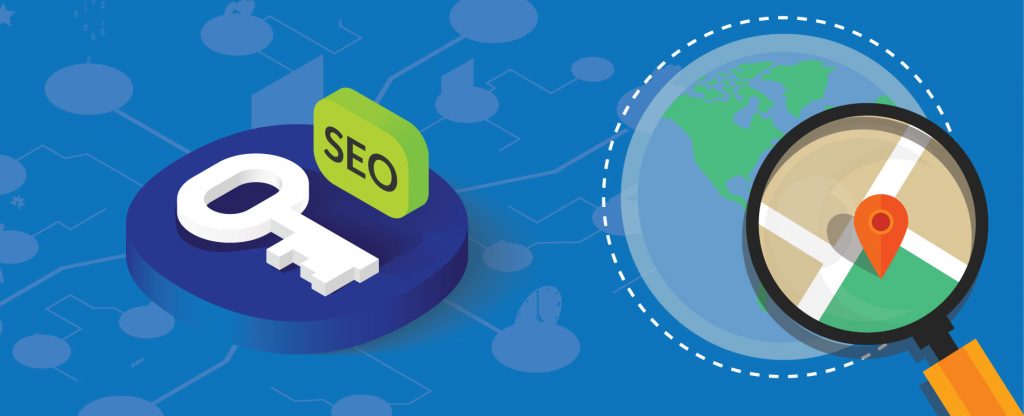
Time Commitment: 7 minutes
What are your client's target keywords? Step one of your local SEO audit should be to determine what they’re currently ranking for and identify any opportunities they might be missing.
For example, if they’re ranking well for ‘Philadelphia Bankruptcy Attorney’ but are nowhere to be found for ‘Philadelphia Bankruptcy Lawyer’, you’ve identified an area to improve.
Start by asking for a list of services, products, or a page your client would like to drive traffic to. Once you have this you’ll be able to use tools like Keyword Finder to quickly put together a list of high volume local target keywords.
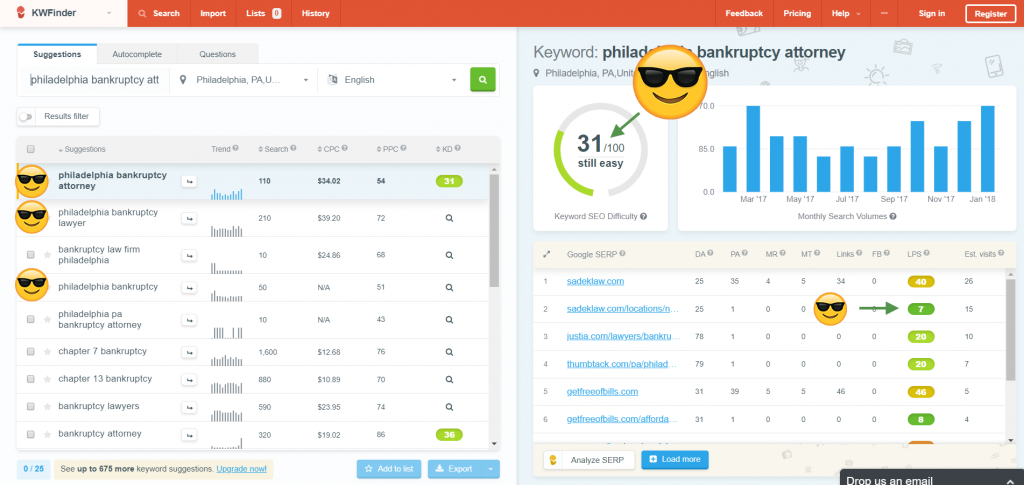
With this list in hand, you can proceed through the rest of your local SEO audit and determine how well these keywords are optimized every step of the way.
A good way to get started with your audit is to use MarketGoo, which automatically scans a website and generates a step-by-step SEO plan to help you increase your website traffic and rankings. There are other helpful local SEO audit tools available to assist you with this process.
Helpful Local SEO Tools:
2. Do a Local SEO Audit on a Competitor

Time Commitment: 7 minutes
Your client’s local SEO audit should include a look at their competitor's SEO profiles early on. Due to their influence on where your client ranks, competitor SEO could be considered an honorary ranking factor in the yearly SEO reports. If your client is located in a highly competitive area in which the other top businesses are doing everything right, you need to document what they're up against.
Doing a competitor local SEO audit early on will give you a frame of reference for everything you discover about your client’s local SEO profile.
You don’t need to do a full-blown diagnostic on each competitor, but take a look at the following, and compare that data against your client’s:
- GBP ranking for top keywords
- Organic rankings for top keywords
- Review quantity and quality
- Number of links
- Site Speed
- Social Stats
In most cases, you should be able to take a look through these items and develop a hypothesis on why your client’s competitor is in the position they're in compared to your client.
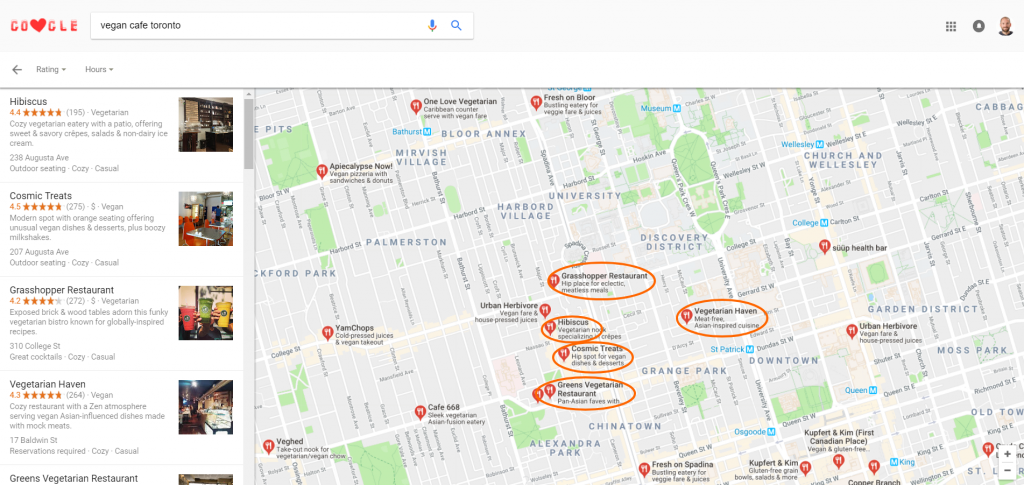
Vendasta partner Elijah Vieau of Techwyse notes that both client and competitor SEO audits can be similar:
We take the same approach to auditing our clients and their competitors with regards to local SEO.
It starts with checking their GBP listing (categories, images, etc). This is followed by a citation crawl using White Spark. We'll pull this into a sheet and manually check each link for accuracy, along with ensuring the NAP is consistent on their website.
Based on this we'll get a heartbeat for their overall citation accuracy, as well as the authority and relevancy of the listings. From our client and competitor analysis, we'll identify gaps in our client's citation profile, and look to ultimately submit their NAP to those directories as needed.
On the keyword side of this, we'll use a tool such as Rank Ranger to track ranking improvements within the local pack over time and use a combination of Google Analytics and GBP Insights to uncover opportunities for local landing optimizations to increase rank and conversions.
Helpful Local SEO Tools:
3. Audit Google Business Profile Listing

Time Commitment: 3 minutes
Google Business Profile is one of the biggest drivers of local SEO success. If you want your client to appear in Google’s “snack pack,” their GBP listing should be robust, and well-optimized with their core target keywords.
During this stage of the local full SEO audit, here are some things to look for:
- Do they have a GBP listing? If so, is it claimed and verified?
- Is all business information present and correct?
- Do they have multiple reviews and a high cumulative rating? Are they responding to reviews?
- Do they have appropriate business categories listed?
- Do they have images of the business?
- Have they created any GBP posts?
- Are they participating in the Questions & Answers section?
These are the core elements that make up a strong GBP listing.
Here's how Eagan Heath of Get Found Madison audits his client's GBP business listings:
Helpful Local SEO Tools:
- Manager access from client to their GBP listing
- Yoast Local SEO Plugin
4. Audit Reviews for Quality and Quantity

Time Commitment: 2 minutes
Reviews pack a ton of clout in both the local ranking and reputation-building arenas. Search engines regard them as a powerful and authentic measure of a local business’s popularity and viability. Plus, potential customers trust reviews as an accurate gauge of that business’s quality level.
Getting an abundance of positive, glowing and wordy reviews across multiple review platforms like GBP, Facebook, Yelp, and vertical-specific sites like Houzz, Tripadvisor, and Healthgrades helps you win on many levels.
Local SEO Guide notes that Google does pick up on the keywords people use in their reviews: “At a high level, having a keyword you are trying to rank for, and a mention of a city you are working to rank in, in reviews has a high correlation with high ranking Google Business Profile results.”
So in addition to review quality and diversity across the top platforms, you’ll want to examine the content of all available reviews to see if your client’s target keywords are present.
Helpful Local SEO Tools:
5. Audit Links for Quality and Quantity

Time Commitment: 3 minutes
Links remain the bread and butter of Google’s ranking algorithm.
Darren Shaw of Whitespark explains,
“Google is still leaning heavily on links as a primary measure of a business’ authority and prominence, and the local search practitioners that invest time and resources to secure quality links for their clients are reaping the ranking rewards.”
A diverse array of quality links is crucial for any local business’s link portfolio. This means that as you conduct your local full SEO audit you’ll need to evaluate your client’s links, looking for links with:
- Local content
- Industry or vertical topic clusters
- High domain authority
Link quality will win over quantity, and quality + quantity will help your client dominate the search rankings in their market. On the flip side, if you see a high volume of spammy, off-topic links, you’ll want to make a note of it as a red flag that may be damaging your client’s ability to rank well for their target keywords.
Our SEO wizard Jubaer Prodhan expands on this,
“Google is rewarding relevancy now than ever before. If you're auditing a local business website, it's better to set aside general SEO metrics and focus more on relevancy. For local SEO, a backlink from the same niche/industry is good, but not relevant enough. A backlink from DA 20 website, which is from the same city and same industry is much much better than a general backlink from DA 60 website. Having said that, don't just mark positive to all the relevant industry or same city backlinks. Check the linking page OBL (outbound links) number, Moz Spam score, and content quality carefully. Clearly, you don't want to get backlinks from a page which Google considers as a LinkFarm or Thin Content page.”
Helpful Local SEO Tools:
6. Audit Schema-Markup for Local

Time Commitment: 2 minutes
Schema markup is code that goes on a website to help search engines return more informative results for users. Schema tells the search engines what your data means, not just what it says.
This markup is a key way to tell search engines exactly what a given website is about, which will help them serve it up on SERPs for the correct search queries.
One way to check to ensure that your client’s site is using schema markup is to enter their URL in Google’s Structured Data Testing Tool. You’ll be able to check to see if all the correct info about the business has been included.
Jubaer walks us through adding schema-markup to your client’s website and individual landing pages:
SMBs often don't realize how important schema-markup is. If you have a local client who isn't using schema-markup on their pages, it's your great opportunity.
First, take a quick look at the keywords and SERP results. It will help you to understand the user intent so you can give the best value. Try to identify which markups (reviews, events, articles, products, etc) can be a good fit for your client's website. Then create a content map and tag which markup you will use for which page. While highlighting/adding information in the markup fields, add information which the user would find most helpful.
To add Schema markup, if it's a WordPress website, "All In One Schema Rich Snippets" is a great plugin. For other websites, Schema markup generator is a good tool to create the code.
Helpful Local SEO Tools:
7. Audit Local SEO Citations

Time Commitment: 3 minutes
How frequently is your client's business mentioned online? Auditing their citations will determine just how many online mentions exist of the name, address, and phone number for their business.
It’s important to look into both your client’s structured and unstructured citations, as they're quite a bit different.
For structured citations, you’ll audit their business listings across the web, looking at social platforms and directories like Yelp, Yellowpages, Facebook, Superpages, and MapQuest. You’ll also need to check to see if their correct business info is listed on the main data aggregators: Axiom, Neustar/Localeze, Factual, and Infogroup.
Next, you’ll need to check your client’s unstructured citations. According to Zachary Yuzdepski,
"An unstructured citation can be found on random websites, blogs, event listings, job posting sites, government records, or social media mentions. These are unstructured because they could be as simple as a company mention. Usually, these citations don’t include a business’s NAP data.”
Helpful Resellable Local SEO Tools:
- Vendasta Reputation Management Software has a "Mention Monitoring" feature
- Yext
- Whitespark Local Citation Finder
- GeoRanker
8. Audit SEO on Main Pages

Time Commitment: 7 minutes
An audit of the main website pages is probably the most important piece of your entire audit. It doesn’t have to be time-consuming if you have the proper tools though. Screaming Frog is one of many excellent tools that’ll deliver a comprehensive look at your client's on-page SEO.
Local SEO expert Jeff Lenney shared some quick tips on using Screaming Frog to audit your client's on-page keyword optimization here:
With your list of target keywords in hand, you’ll want to run through each page on your spreadsheet (as Jeff demonstrated) looking over the keywords on each page. Specifically, you’ll be looking at the:
- Page name
- Title tags
- Sub-headings
- Word count
- Meta description
Even with just this information, you’ll be well-equipped to analyze how well their pages are optimized for local SEO. Plus, you’ll be able to recommend improvements and content gaps that might be missing.
Once you’ve evaluated and recorded the weaknesses in your client’s local SEO (and they’ve hired you to save the day) you can make use of a host of top-tier SEO plugins to help you do your work.
Helpful Local SEO Tools:
9. Audit Image SEO

Time Commitment: 3 minutes
There are two main components to image optimization for local SEO: keyword usage and how images affect page load speed.
You can use Screaming Frog to evaluate both.
Keyword Usage: Auditing image keyword optimization boils down to evaluating each image’s filename and alt text. Since Google can’t yet tell what visual content an image contains, site crawlers rely on things like the filename and alt text to determine what’s being displayed. These are places that should be optimized with relevant target keywords.
Page Load Speed: You can get some big improvements in page load speed when images are optimized to reduce their file size without significantly impacting their visual quality. Using Screaming Frog, you can take an inventory of all the images on your client’s site and highlight the images that are slowing things down. (There are also image size optimization plugins that resize images automatically going forward.)
Helpful Local SEO Tools:
10. Check Website Speed

Time Commitment: 1 minute
Having a site that loads rapidly is crucial in today’s online business environment. A vital step in your local SEO audit, site speed is a big reason customers stay on or leave a page.
Edwin Toonen of Yoast notes that,
“Google’s latest research shows that the chance of a bounce increases 32% when the page load time goes from 1s to 3s. 1s to 5s increases the chance to 90%, and if your site takes up to 10s to load, the chance of a bounce increases to 123%. That’s incredible. For search engines, better results and performance is a sign of a healthy site that pleases customers and therefore should be rewarded with a higher ranking.”
Google PageSpeed Insights Tool performs a near-instant audit of a given URL for both mobile and desktop searches. This will give you a quick way to tell if improvements are needed, and a list of actions to take to improve your client's website speed.
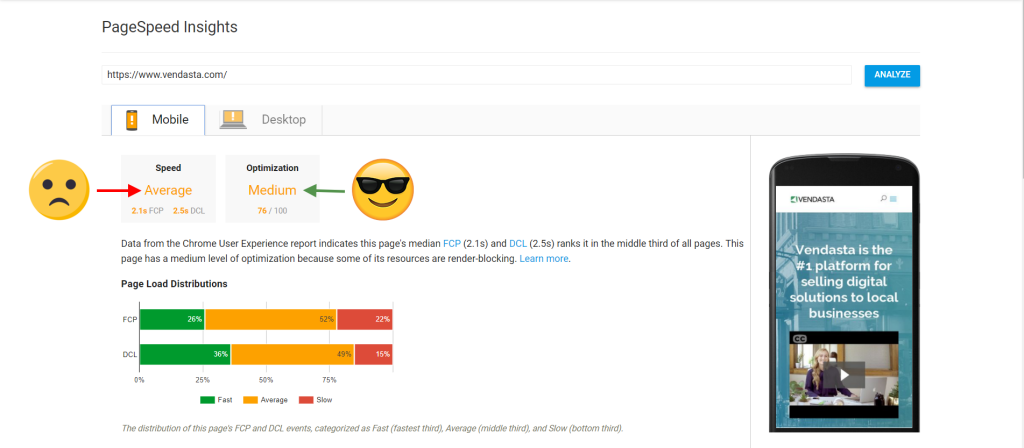
Helpful Local SEO Tools:
11. Audit Site Engagement

Time Commitment: 3 minutes
What visitors do when they discover your client’s business online affects their rankings. In fact, David Mihm argues that “Engagement is simply a much more accurate signal of the quality of local businesses than the traditional ranking factors of links, directory citations, and even reviews.”
Metrics like organic search click-through rate (CTR), dwell time, bounce rate, and conversion rate are all ranking factors. You can simply use Google Analytics (You’ll need access from your client) to examine your client’s engagement metrics and compare them to industry benchmarks during your local SEO audit.
Helpful Local SEO Audit Tools:
12. Audit Social Engagement

Time Commitment: 3 minutes
The truth is that we’re not sure to what extent social signals are baked into Google’s ranking algorithm. However, there’s no doubt that a strong social media presence can significantly boost local SEO efforts.
According to Ron Dod of Visiture, the bigger and more engaged your client’s audience is, the more they’ll be able to boost rankings:
“The bigger your brand is and the more consumers trust you, the more likely you are to receive a larger share of clicks in Google. Social media can be a great and efficient way to help you build your brand and get in front of people who wouldn’t have otherwise found you.”
Cornelia Cozmiuc of Cognitive SEO shares thoughts on a recent study on whether social signals influence SEO,
“It’s probably also worth mentioning another recent adage, coming from the creator of the XKCD web comic, which states that “correlation does not imply causation, but it does waggle its eyebrows suggestively and gesture furtively while mouthing ‘look over there.’“ Which is to say that just because we cannot definitely state that more shares on a social network will lead to a higher position in the rankings list, it doesn’t mean it can’t happen."
Therefore, evaluating your client’s social platforms is an essential part of your local SEO audit.
- Number of people that like your client’s page on Facebook + Facebook shares
- Number of Twitter followers + tweets mentioning their brand name
- Number of LinkedIn company followers and LinkedIn Shares
Here’s how to use Buzzsumo to see your client’s top social shares:
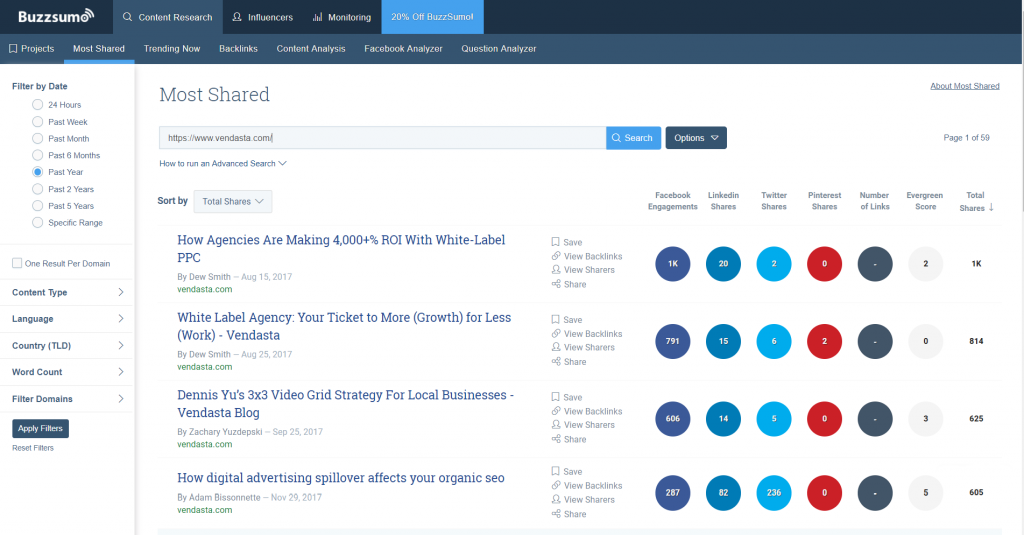
Helpful Local SEO Audit Tools:
- Check MarketGoo's social engagement reporting
- Use NameCHK to find all social media profiles
- Use Buzzsumo to find your client’s most shared content
13. Bonus: How to Report Your Local SEO Audit Results
Your clients don’t want a 3-hour masterclass on local SEO. You may not even need to cover each step of your local SEO audit. The main information to convey is that the gaps you found will prevent their site from ranking as well as it could for their target keywords.
What you’ll want to focus on is how long it’ll take to fix the optimization issues that you found, how much it’ll cost them, and a ballpark estimate on the areas you expect will improve. The last part of this is the hardest. It’s incredibly hard to make predictions because there are so many factors involved in local SEO.
You can present your local SEO audit report in whichever manner you and your clients prefer. For some clients, a written report may be enough. However, most will want and need a bit more explanation from you.
Vendasta partner Phil Tucker of Be Famous Media has developed a useful approach to sharing audit reports with clients:
“I usually will do reports and have PDFs that will show historical ranking changes and where they rank, depending on the client, in Google, Google Maps, Google Mobile, Yahoo, and Bing. I may even make a screenshot video of myself going over the report and digging into results a bit. I find the video is good because I can make the video whenever I want, and they can watch it whenever they want it, versus an actual screen share.”
Another tip from Phil is that taking a consultative approach to your report to clients is key. Correct local SEO is a means to an end: getting leads!
“One of the things I've been working on is really making sure the customer understands that we're in this together. It's not just the ranking that matters, but also what happens after the traffic gets to their website. That way, even if they don't necessarily have the budget for my recommendations today, it’s still in the back of their mind. So down the road, as the campaign progresses, it's an easier conversation of, "Oh, yeah, remember when we talked about that?" It's a lot easier to upsell them to get a website that's converting well, not just ranking well.”
Final Thoughts
Performing a comprehensive local SEO audit using the 12 steps we have outlined is going to dredge up issues, no matter which business you audit. However, local SEO is still a mystery to many local businesses, so educating your clients on the value of this work is key.
Finding and fixing any SEO optimization issues you discover along the way is also crucial, as is recording your progress to ensure you’re not missing any vital pieces of the local SEO puzzle. Using a local SEO audit checklist will help with your optimization progress and prevent any missed steps.
Once you're ready to get started optimizing your website for SEO, using Boostability's and SEO Network's SEO packages are key ways to power up your local presence. Just contact us for more info on any of these products.
[adrotate banner="83"]

